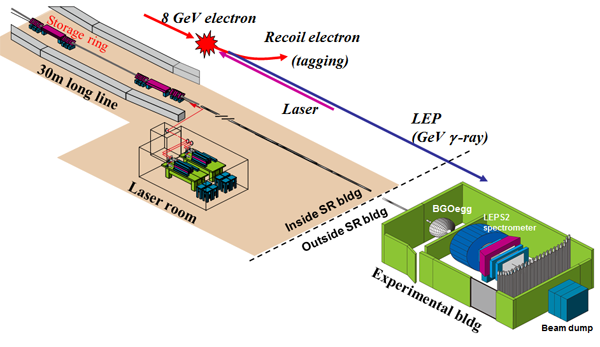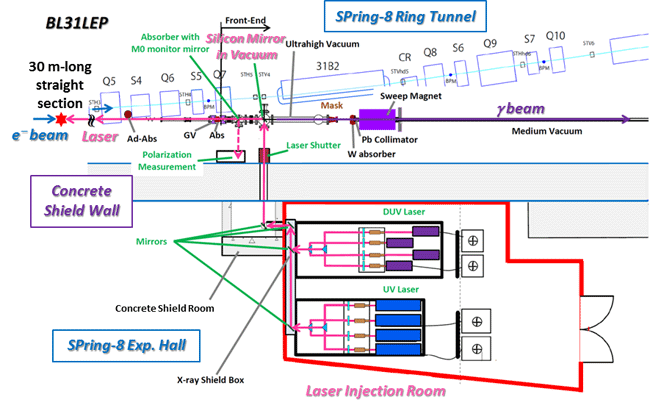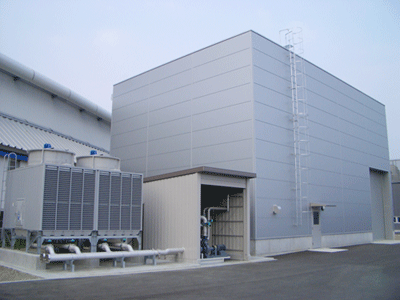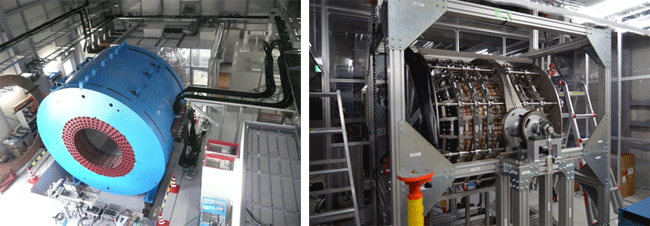BL31LEP OUTLINE
問い合わせ番号
INS-0000001564
ABSTRACT
The laser-electron photon (LEP) beam is a polarized GeV gamma-ray beam which is produced by backward Compton scattering of injected ultraviolet (or deep ultraviolet) laser photon off circulating 8-GeV electrons. The wavelength of such a high energy photon is shorter than the typical size of a hadron (~1 fm) and then we can use this beam to investigate the sub-structure of hadron, i.e., the quark world. The LEPS experiment at BL33LEP beamline has already been performed since 1999. We have made the hadron photoproduction by irradiating the LEP beam to mainly liquid hydrogen and liquid deuterium targets, and obtained many important results such as a hint of existence of the pentaquark Θ+, the study of the baryon resonances, etc. However the beam intensity and the narrow experimental space have limited the statistical accuracy and investigation of the production and decay mechanism.
The BL31LEP has been constructed as the second LEP beamline. We have obtained the first beam in January, 2013 and started the commissioning. The photon energies between 1.4 GeV and 3.0 GeV are determined by tagging the electrons which are recoiled in Compton scattering and passing through the Al window of CR1 chamber downstream of the BM1 magnet. Thus we can measure photoproduction reactions in the wide energy region simultaneously. In the LEPS2 experiment at BL31LEP, two upgrades are the key ingredients, the intensity upgrade about one order and the construction of the large acceptance and high resolution detectors. The former is achieved by the simultaneous injection of multi-number of high power lasers. For the latter, we have constructed a large experimental building outside the storage ring building. By using this high intensity beam and large detectors, we aim to make greater progress in the study of quark-nuclear physics.
Bird’s-eye view of the BL31LEP
AREA OF RESEARCH
- Production of high intensity GeV photon beam by laser-backward Compton scattering
- Hadron physics via photo-nucleon and photo-nuclear reactions
- Test and calibration of detectors with GeV gamma-ray or converted electrons/positrons
KEYWORDS
- Scientific field
Quark-nuclear physics, Hadron photoproduction, Laser-electron photon, Polarization, Pentaquark, Exotic states, Mass shift in the nuclear medium - Equipment
UV laser, Deep UV laser, Tagging counter, BGO electromagnetic calorimeter, Large acceptance spectrometer, Drift chamber, Time projection chamber, Resistive plate Chamber, Neutron Hodoscope, TOP counter, SSD, Polarized photon, Polarized target, High-speed data acquisition system
SOURCE AND OPTICS
The photon source is the scattering point of circulating electrons in the storage ring and laser photons injected from outside. The lasers are placed in the clean room outside of the side wall of the ring tunnel. Since the electron beam divergence in the long straight line is the smallest (12 μrad), the thin and parallel LEP beam can be obtained. In order to expand the aperture size for four laser injection and to tag the recoil electrons, some vacuum chambers in cell 31 were replaced by new ones.
In the laser injection room, two solid tables are placed for 355-nm lasers and 266-nm lasers, respectively. Four lasers are put on each table and can be injected simultaneously through the prism mirrors. Using 355-nm lasers, the maximum energy is 2.4 GeV and the intensity is high, while the maximum energy is 2.9 GeV and the intensity is one order low by using 266-nm lasers. Depending on the experimental purpose, we can choose preferable one.
Schematic view of the storage ring around BL31LEP long straight line
Laser Injection Room and the Front End in the ring tunnel
EXPERIMENTAL STATIONS
- Beam
Energy Range (tagged photon) 1.4 - 2.4 GeV (355-nm UV Solid-state laser)
1.4 - 2.9 GeV (266-nm DUV Solid-state laser)Energy Resolution < 15 MeV Photon Flux < 2 x 107 photons/s (355-nm lasers)
< 2 x 106 photons/s (266-nm lasers) - Experimental building
The LEPS2 experimental building, which has an area of 18 m x 12 m, was constructed 135-m downstream of the collision point of electrons and laser photons, and the construction was completed in March, 2011. The produced LEP beam is transported to the experimental building through vacuum pipes. - Detectors
Detectors for the LEPS2 large charged particle spectrometer will be placed inside the 1 T solenoid magnet with 5-m diameter and 400-t weight. The magnet, which had been used in the kaon rare decay experiment (E949) at the Brookhaven National Laboratory, has a large bore of 2.22-m length and 2.96-m diameter. We intend to start operation of the LEPS2 spectrometer in 2015. Large acceptance tracking detectors, high resolution particle identification detectors, etc., are under development and construction.
In the space upstream of the solenoid magnet, an electromagnetic calorimeter covered a large solid angle, called BGOegg, is placed, which has been constructed in the ELPH, Tohoku University. The BGOegg consists of 1320 BGO crystals with 20 radiation length assembled to an egg shape and has the highest energy resolution in the world. The experiment using the BGOegg starts from 2013B, together with a forward TOF counter composed of the array of resistive plate chambers (RPC).
(left) Large solenoid magnet with 5-m diameter transported from BNL
(right) Electromagnetic calorimeter ‘BGOegg’ inside the thermal controlled room
LEPS2 experimental building and the cooling system
PUBLICATION SEARCH
BL31LEP PUBLICATION SEARCH
CONTACT INFORMATION
Takatsugu ISHIKAWA
Research Center for Nuclear Physics, Osaka University
10-1 Mihogaoka, Ibaraki, Osaka 567-0047
Phone : +81-(0)6-6879-8942
e-mail : ishikawa rcnp.osaka-u.ac.jp
rcnp.osaka-u.ac.jp
Website
http://www.rcnp.osaka-u.ac.jp/Divisions/np1-b/?LEPS2_%28BL31LEP%29




